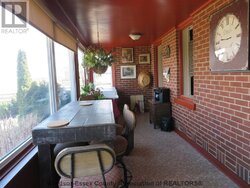Hey All!
Stove is a regency f2400 with glass door. Every so often I put the blower fan on to get more heat, or if I feel I'm a little to hot to overfiring, and I worry about the wood paneling getting too hot. I have a large mirror and was wondering if I could put it in front of the paneling?
An old pic from the realtor, the stove is right where the large clock is, facing the windows. You can just see behind the table, the wainscotting panel.
The clearance is to code (was installed professionally), but just still worried about the paneling. Anyone know what heat resistance mirror can stand up to?
Thanks in advance!
EDIT:



I don't need a heat shield, I'm within clearance.
I *want* extra (and I have a mirror that fits nice there), and would like to know what temps can a mirror hold up to?
Stove is a regency f2400 with glass door. Every so often I put the blower fan on to get more heat, or if I feel I'm a little to hot to overfiring, and I worry about the wood paneling getting too hot. I have a large mirror and was wondering if I could put it in front of the paneling?
An old pic from the realtor, the stove is right where the large clock is, facing the windows. You can just see behind the table, the wainscotting panel.
The clearance is to code (was installed professionally), but just still worried about the paneling. Anyone know what heat resistance mirror can stand up to?
Thanks in advance!
EDIT:




I don't need a heat shield, I'm within clearance.
I *want* extra (and I have a mirror that fits nice there), and would like to know what temps can a mirror hold up to?
Attachments
Last edited:





